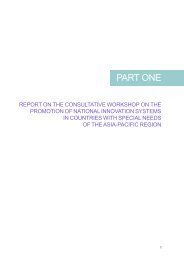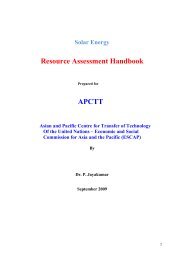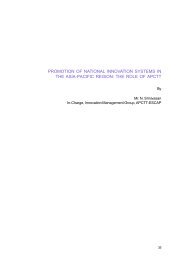Download Complete PDF - apctt
Download Complete PDF - apctt
Download Complete PDF - apctt
- No tags were found...
You also want an ePaper? Increase the reach of your titles
YUMPU automatically turns print PDFs into web optimized ePapers that Google loves.
In the case of gas-based thermal plants, for a 30 MW plant, the typical efficiency is24.4 per cent (3,251 kcal/kWh) for open cycle and 39 per cent (2,177 kcal/kWh) forclosed cycle.B. Key drivers for energy conservation in IndiaThe key aspects that drive energy conservation efforts in India are:• Low per capita energy consumption – Around 704 kWh, compared with 13,241kWh in the United States, 1,139 kWh in China and around 4,000 kWh world average;• Reliability issues – High downtime of power plants that decreases the averagedthermodynamic efficiency of plants and results in loss of revenue to power generationcompanies;• Energy reserves not proportionate to population;• High cost of energy;• Higher specific energy consumption by the processing sector;• High cost of setting up new power plants; and• Demand and supply gap, with peak shortages up to 25 per cent (all-India averageis 11 per cent).India is the fifth largest energy consumer in the world, although 35 per cent of the 1.21billion population is not grid-connected – that is about 425 million people, more thanthe population of the United States. Currently, India meets close to 30 per cent of itsenergy needs through imports and this is likely to increase in the future.In thermal power generation, coal accounts for 83.65 per cent with 96.74 GW installedcapacity, followed by gas with 17.71 GW (15.31 per cent) and oil with 1.2 GW (1.03per cent). While the efficiency is an average 30 per cent, transmission and distributionlosses run up to 30-35 per cent, burdening the State Electricity Boards with a whoppingannual loss of around Rs 200 billion! The average cost per unit (kWh) of power is high inIndia – US$0.095, compared with US$0.062 in China, US$0.060 in the United Statesand US$0.58 in the Republic of Korea.Table 3-10: A comparison of Indian and global energy reservesType India World PercentageOil (mt) 800 138,300 0.58Gas (mtoe) 700 139,700 0.5Coal (mt) 69,947 1,031,610 6.78Hydro (mtoe) 30 218 13.76Nuclear (mt Uranium) 100,000 10,000,000 1.00Table 3-10 provides the energy reserves of India in comparison with global figures.Compared with its counterpart in developed nations, the Indian industry incurs a highercost for use of power in production (Table 3-11). The intensity of energy usage inproduction too is comparatively higher in the Indian industry than in the industrialsector in developed nations.113







